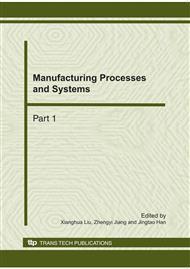p.702
p.707
p.711
p.715
p.721
p.728
p.732
p.736
p.740
Stress Analysis and Formability of Sheets in Semi-Ball Bottom Cylindrical Deep Drawing
Abstract:
Semi-ball bottom cylindrical deep drawing is different from the traditional deep drawing, since it is not only characteristics of traditional drawing, but also of bulging. According to the semi-ball bottom cylindrical deep drawing features, the stress conditions of the sheet in different regions have been analyzed by a mathematical modelling. In addition, the effects of processing parameters on the forming limit of the sheet in semi-ball bottom cylindrical deep drawing have been investigated by experimental method and simulation based on dynaform, respectively. It is found that the experimental results are consistent to that in simulation and the results show that the formability of the sheet is influenced greatly by the blank holder force, friction coefficient and thickness. With the blank holder force and friction coefficient decreasing and the thickness increasing, the bulging area can be expanded, which is beneficial to the improvement of the forming limit height of the semi-ball bottom cylindrical deep drawing parts.
Info:
Periodical:
Pages:
721-727
Citation:
Online since:
October 2010
Authors:
Keywords:
Price:
Сopyright:
© 2011 Trans Tech Publications Ltd. All Rights Reserved
Share:
Citation:


